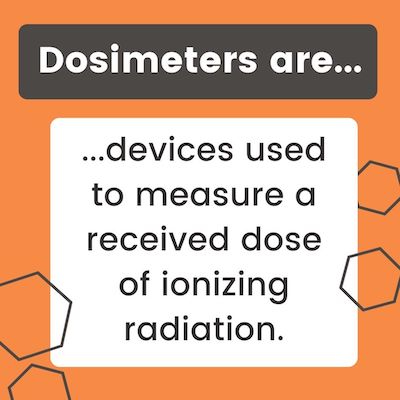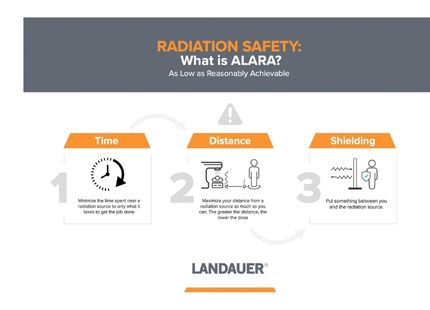
What is Dosimetry? The Facts and Fundamentals of Radiation Dosimetry
What is Dosimetry?
Dosimetry is the scientific method and measurement of ionizing radiation. It plays a crucial role in the protection of workers in varying industries, from the medical field to the nuclear sector, especially since the purpose of dosimetry is to track the level of radiation exposure. This is accomplished through the use of dosimeters, which are devices used to measure a received dose of ionizing radiation.


“It is important to understand that there is no stated safe level of radiation exposure,” explains Kenneth Repking, a Practice Associate with Landauer Medical Physics Radiation Safety Support Services. “No matter how low the exposure is, the risk is low, but the risk is nevertheless still present.”
Even with the improvement in technology in recent years, it’s vital to track radiation exposure due to these risks. One of the best ways to do that is through dosimetry programs. As experts in dosimetry, we at Landauer know these programs are key to protecting workers and ensuring companies are compliant with all the regulations. But before creating a dosimetry program, you need to know the basics of radiation dosimetry.
What is Dosimetry Table of Contents:
- Fundamentals of Radiation Dosimetry
- Types of Ionizing Radiation
- Radiation Exposure
- External Dosimetry vs. Internal Dosimetry
- How is Radiation Exposure Measured
- Dosimetry FAQ
Fundamentals of Radiation Dosimetry
Radiation dosimetry is a term used interchangeably with dosimetry. Fundamentally, radiation dosimetry reads and tracks ionizing radiation, which is the energy that breaks electrons from atoms and molecules. This process of ionization can happen because of both natural elements (i.e. radon) and human-made ones (i.e. X-rays).
Types of Ionizing Radiation
There are five common types of ionizing radiation. We’ve listed them below from weakest to strongest. However, it’s important to note that all five types can be dangerous to humans depending on the amount and type of exposure.
- Alpha
- Beta
- X-rays
- Gamma
- Neutron

Alpha Radiation
Also known as alpha particles (α), this type of radiation is found in isotopes of elements like radium, radon, and uranium. It is not strong enough to penetrate human skin; in fact, it can be blocked by something as flimsy as paper. However, it can become very dangerous if it finds its way inside the body internally. This can be through breathing it in, swallowing it, or through an open wound or cut. A common example of alpha particles is radon, which can come from the soil in the ground, rocks, or even water. People can be exposed to it in their homes, and it is something that is now monitored and measured in houses.
Beta Radiation
Commonly referred to as beta particles (β), these particles are stronger than alpha particles and can penetrate human skin and cause burns. While dangerous, this form of radiation cannot reach inner organs, and certain types of clothing such as rubber gloves, lead aprons, and a HEPA respirator mask can act as a barrier to help lower some exposure. Periodic elements that can emit this are certain isotopes of carbon, strontium, and phosphorous. Similar to alpha radiation, this can become hazardous if inhaled or ingested. Beta radiation is used by some medical professionals for cancer treatments, but it is also used for quality control. For example, the manufacturing industry uses it to test the thickness of paper.
X-Rays
X-rays are a form of electromagnetic radiation that is arguably one of the most recognized types of radiation because of its use in medical care. X-ray machines are widely used in medical offices across the nation and are considered one of the most prominent human-made sources of radiation exposure. X-rays pass into and through the human body unless blocked by strong shields such as lead aprons. One natural source of X-rays is the sun, although exposure is only a concern for people who fly frequently such as pilots or stewards. However, this exposure is very low and is typically only around 12% of the annual limit a radiation occupational worker is allowed to receive.
Gamma Rays
Gamma rays (γ) are also a form of electromagnetic radiation, but while they can also pass through the human body, they are slightly different than X-rays. X-rays and gamma rays are both photons. X-rays originate from the electron orbits of an atom while gamma rays are emitted from the atom’s nucleus. The energy range of X-rays tends to be lower than the energy range of gamma rays making the penetrating power lower. Solar flares can emit gamma rays, causing interference with electronics. Gamma rays can be emitted through human-made equipment such as sterilizers, medical imaging units, and even smoke detectors.
Neutron Radiation
Another name for neutron radiation is nuclear particles. This is considered one of the most powerful forms of ionizing radiation and, of the five types of radiation mentioned here, is the only one that can make things radioactive. These particles can break through not only the human body but other dense materials due to their high penetrating power. These can be found within a nuclear reactor, but they are kept in check with strong shielding, including water. Neutron radiation exposure also occurs when a nuclear weapon is detonated.
Radiation Exposure
Humans can become exposed to radiation both internally and externally. Internal radiation exposure can happen in five different ways:
- Eating/drinking contaminated substances
- Inhaling radioactive airborne particles
- Skin absorption through exposure to a radioactive particle or liquid
- Entrance of radioactive material through a wound
- Injection of a radioactive material
 External radiation exposure occurs when all or part of the body is exposed to penetrating radiation from an external source. This can occur because of normal background radiation that is naturally present in the environment or can be deliberate such as radiation exposure when having an X-ray taken.
External radiation exposure occurs when all or part of the body is exposed to penetrating radiation from an external source. This can occur because of normal background radiation that is naturally present in the environment or can be deliberate such as radiation exposure when having an X-ray taken.
Some people work more closely with ionizing radiation, leading to occupational radiation exposure. Occupational radiation exposure is the radiation exposure that people experience because of their careers. According to the United States Nuclear Regulatory Commission, it is defined as, “the internal and external dose of ionizing radiation received by workers in the course of employment in such areas as fuel cycle facilities, industrial radiography, nuclear medicine, and nuclear power plants.”
People working in certain industries such as healthcare, air transportation, non-destructive testing, military, or nuclear power plants will be impacted more by radiation than those in other fields of work.
 There are federal and state regulations and compliance requirements to protect workers who are exposed to occupational radiation. Part of these requirements is to minimize exposure and maintain records of exposure over a long period of time. One safety protocol that is followed is ALARA (As Low as Reasonably Achievable).
There are federal and state regulations and compliance requirements to protect workers who are exposed to occupational radiation. Part of these requirements is to minimize exposure and maintain records of exposure over a long period of time. One safety protocol that is followed is ALARA (As Low as Reasonably Achievable).
“By employing the ALARA concepts of Time, Distance, and Shielding, a radiation worker can effectively minimize their occupational radiation exposure,” says Christine Krieman, Practice Associate with Landauer Medical Physics. “Wearing a dosimeter provides the direct dose measurement to demonstrate that occupational exposure limits are not exceeded.”
Dosimetry programs are an ideal way to monitor those at risk of occupational radiation exposure. These radiation protection programs are designed to solidify, simplify, and organize the process of tracking radiation exposure for employees. It verifies that workers have accurate readings and ensured post-installation surveys are also resources used to ensure the safety of the workers and the general public.
External Dosimetry vs. Internal Dosimetry
Since radiation exposure can happen both externally and internally, there are two types of dosimetry methods used to keep track of the exposure - aptly called external dosimetry and internal dosimetry.
 External dosimetry is our specialty here at Landauer. This is the method of measuring radiation dose caused by exposure to radiation outside of the body. The main way to track exposure is through the proper wearing of dosimeters, which are also referred to as radiation badges. Dosimeters are designed to measure anything from X-rays to gamma rays and even neutron and beta exposure. Some specialized dosimeters can accurately measure more than one radiation type.
External dosimetry is our specialty here at Landauer. This is the method of measuring radiation dose caused by exposure to radiation outside of the body. The main way to track exposure is through the proper wearing of dosimeters, which are also referred to as radiation badges. Dosimeters are designed to measure anything from X-rays to gamma rays and even neutron and beta exposure. Some specialized dosimeters can accurately measure more than one radiation type.
Internal Dosimetry is the process of measuring radiation exposure if and when radiation is inhaled, ingested, or entered into the body through anything from a wound to an injection of something used to treat cancer. Experts will need to determine the committed effective dose equivalent (CEDE) to understand the level of exposure that occurred.
How is Radiation Exposure Measured
Facilities that possess radioactive materials or radiation-generating equipment must adhere to their internal policies and procedures and also maintain compliance with regulations and standards set forth by state, city, county, and even accrediting organization requirements when it comes to radiation safety and exposure standards.
While these standards can vary widely, there are three universal measurements to keep in mind when it comes to measuring radiation: emitted radiation, the radiation dose, and the biological risk.
Emitted Radiation
Emitted radiation is the radiation that is released when an atom is unstable or radioactive. Emitted radiation can also refer to the photon beam which is produced by an X-ray tube. The standard unit which describes the exposure of X-ray or gamma ray photon radiation in air is the Roentgen. However, this unit does not convey how that radiation is impacting a person.
Radiation Dose
A radiation dose describes how much radiation a person absorbs when exposed to radiation. It’s often referred to as a radiation absorbed dose (RAD). This can be measured using a couple of different units known as rad or Gy. This radiation dose measurement will help determine how much radiation a person absorbs, but biological risk takes it one step further to determine how dangerous the exposure could be.
Biological Risk
This radiation measurement determines how the radiation exposure can impact a person’s health. The first step is to determine a quality factor (Q), which is calculated using the type of ionizing radiation the person was exposed to at the time. From there, you need to multiply the quality factor by the RAD to determine the Roentgen Equivalent in Man (REM) or Sv. REM is the biological effectiveness or risk that the absorbed dose causes.
Dosimetry FAQs
Below are some frequently asked questions about dosimetry and the answers to them.
Q: What is the purpose of dosimetry?
A: The overarching purpose of dosimetry is to measure and read ionizing radiation levels. However, the main way people use dosimetry is to track radiation exposure and its impact on people and the environment.
Q: What is personal dosimetry?
A: Personal dosimetry is the manner of tracking an individual’s radiation exposure (as opposed to the environment) through technology such as dosimeters.
Q: How does personal dosimetry work?
A: Personal dosimetry tracks radiation doses and exposure levels using dosimeters. This is done by constantly tracking radiation exposure to determine how much radiation the individual has been exposed to over time.
Q: What is a medical dosimetrist?
A: A medical dosimetrist is a person who manages and determines how much radiation patients with illnesses such as cancer should get when receiving medical treatment. Medical dosimetrists need a Bachelor of Science degree and must complete an accredited medical dosimetry program. They’ll also need to pass a Medical Dosimetrist Certification Exam.
Q: What are the different types of dosimeters?
A: Dosimeters are split into four main types based on their placements and purposes: whole body dosimeters, ring dosimeters, lens of eye dosimeters, and area dosimeters. When it comes to their technology and functionality, there are several different types of dosimeters including passive, electronic, pocket, alarms, digital, and real-time.
